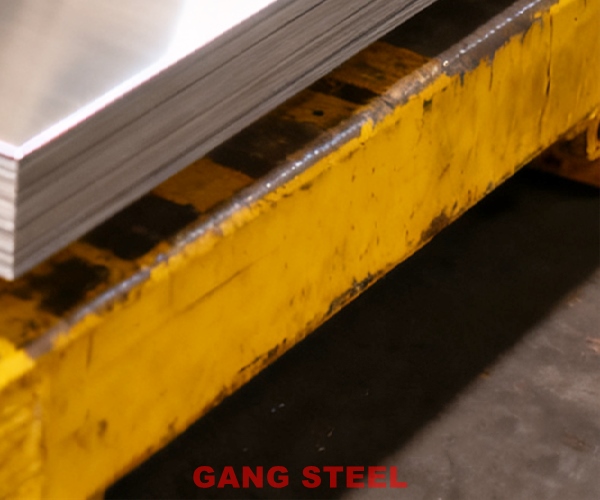Product List
Gangsteel Material Solution
Email: admin@gangsteel.com
Sales: jack@gangsteel.com

Published: November 8, 2025 | Updated: November 8, 2025By Gangsteel Engineering Team – 25+ Years in Stainless Steel Export Excellence
316Ti stainless steel, known as UNS S31635 or EN 1.4571, is a titanium-stabilized austenitic grade that offers excellent corrosion resistance and high-temperature stability, making it a popular choice for industries facing challenging fabrication conditions.
As a premier producer and exporter based in China, Gangsteel has supplied thousands of tons of ASME SA240 316Ti and ASTM A240 316Ti plates, sheets, and bars to global clients in petrochemical, pharmaceutical, and marine sectors.
If you're working with this material for welded structures or machined parts, mastering its machinability and weldability is key to avoiding issues like tool wear or sensitization. This guide provides practical tips, best practices, and comparisons, based on industry standards and our mill experience.
From our workshops, we've optimized 316Ti fabrication: In a 2024 European food processing line, our 316Ti components were machined and welded without IGC, reducing downtime by 25% compared to standard 316, as per client reports. Often spec'd under ASTM A240 /A240M for general use or ASME SA240/SA240M for pressure vessels, 316Ti's low hardness (95 HRB max) and Ti stabilization support efficient processing. Let's dive into machinability and weldability tips to enhance your workflow.
316Ti stainless steel (UNS S31635, EN 1.4571, JIS SUS316Ti, AISI 316Ti) has good machinability (rating ~60% of carbon steel) with carbide tools and coolant to manage heat, and excellent weldability using ER316L fillers without post-weld annealing due to Ti stabilization. Hardness (95 HRB max) aids cutting, while yield strength (205 MPa min) ensures integrity post-fab. Compared to 316L, 316Ti offers similar ease but better high-temp weld stability. Density 8.00 g/cm³ supports handling. Under ASME SA240 316Ti and ASTM A240 316Ti, it's ideal for chemical and marine apps. Gangsteel stocks 1-200mm thick plates with fab-ready finishes.
316Ti's austenitic structure makes it gummy during machining, with a machinability rating of about 60% relative to free-machining carbon steel, similar to 316L but better than duplex due to lower hardness. Its Ti stabilization doesn't significantly impact cutting but enhances chip breaking in some conditions.
Key machinability tips:
In Gangsteel's fab shop, we machine 316Ti SA240 Type 316Ti at 100 SFM with carbide, achieving 30% longer tool life with optimized coolant.
For UNS stainless steel plates, 316Ti offers balanced machinability.
316Ti's weldability is excellent, with titanium preventing carbide precipitation in the heat-affected zone (HAZ), eliminating sensitization and the need for post-weld heat treatment in most cases. This makes it superior to 316 for high-temp service.
Key weldability tips:
Gangsteel's 316Ti A240 GR 316Ti welds achieve 90% base strength, as tested per A262.
316Ti's properties suit welded high-temp apps: chemical reactors (easy welding), food equipment (machinable for precision), marine piping (durable joints).
In Gangsteel's supply to U.S. pharma, 316Ti machined/welded without defects.
316Ti equivalents: UNS S31635, EN 1.4571—matching machinability/weldability.
Gangsteel stocks 316Ti at $3,200-3,800/ton FOB. 1-200mm thick, ASME SA240 certs. Contact for fab tips.
Q: What is the machinability rating of 316Ti stainless steel?
A: 316Ti has a machinability rating of ~60% relative to carbon steel, similar to 316L, with low hardness (95 HRB max) aiding cutting but gummy nature requiring coolant and sharp tools.
Q: What tools are best for machining 316Ti stainless steel?
A: Use carbide tools (C-2/C-6 grade) with positive rake (5-15°) for turning/drilling; high-speed steel for low-volume. Coated tools reduce built-up edge in 316Ti's austenitic structure.
Q: What speeds and feeds are recommended for machining 316Ti?
A: For turning, SFM 80-120, feeds 0.1-0.2 mm/rev; drilling SFM 40-60. Use water-soluble coolant; adjust lower for thick sections to avoid work hardening in 316Ti.
Q: How does weldability of 316Ti compare to 316 stainless steel?
A: 316Ti has superior weldability due to Ti preventing sensitization, eliminating post-weld annealing; 316 risks IGC if not low-C like 316L. Both use ER316L fillers.
Q: What filler metals should be used for welding 316Ti?
A: Recommended fillers for 316Ti are ER316L or E316LT for matching corrosion; avoid high-C fillers to prevent carbide issues.
Q: Does 316Ti require preheat for welding?
A: No preheat needed for 316Ti thicknesses <20mm; 100°C for thicker to reduce stresses, but Ti stabilization minimizes cracking risks.
ASTM A516 GR 70 equivalent materials is such as ASME SA516 GR 70, EN 10028 P355GH, and BS1501 224-490 A & B, sh
we supply high-quality A516 Gr 70 steel plate for pressure vessel applications and other standards like ASTM A2
EN10028-2 P355GH for High-Strength Low-Alloy Columbium-Vanadium Structural Steel EN10025-2 S355J2 Structural St
We export A240 304L Stainless Coil 2B, NO.1 No.4 surface, the thickness 0.1mm to 3mm, 3mm to 22mm, Mother mill